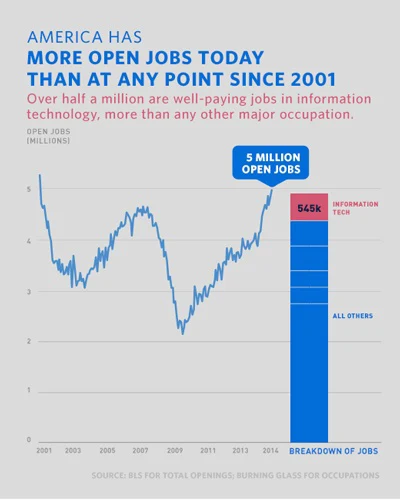
With the words ‘talent gap’ becoming a buzz phrase, many journalists are taking the contrarian angle and offering that the technology talent gap isn’t real. These journalists suggest the talent gap in any given company is a result of a gap in their willingness to invest in talented people or attract STEM (science, technology, engineering, mathematics) capable employees.
The reality is while one company may offer superior talent attraction techniques, there is a limited number of technical talent in the education funnel for our country to fill forecasted job requirements. If your company (and our country) is to thrive in the coming decades we must look at this technology talent gap as a WAR and act accordingly. Here’s how our country and communities are fighting against the tech talent gap and the solutions we all can take to win this war.
National IT Talent Gap Initiatives
A little over a year ago, President Obama announced the White House Tech Hire Initiative. As data showed, today’s talent gap has over 545,000 IT jobs that need to be filled while lacking sufficient candidates. Just recently the White House announced the doubling of the tech hire initiative in a recent 2016 press release.
These jobs aren’t for just Silicon Valley, either; every company in America has to innovate to remain competitive against global competition. Some of the jobs that are in high demand listed below may not require advanced degrees, just specialized training:
- Cybersecurity
- Project Management
- Coding (software programmers)
- UI Design
- Data Analytics
- Network Administration
“When these tech jobs go unfilled, it’s a missed opportunity for the workers, but it’s also a missed opportunity for your city, your community, your county, your state, and our nation”
– President Barack Obama, National League of Cities Annual Conference
The White House Tech Hire Initiative is nationalizing the discussion on many of the strategies that are bridging this gap. These include opening up hiring practices to non-traditional methods, educational models of training that prepare students in months rather than years, and active local leaders connecting people to ramp up programs and the jobs needed filling. Find more details, as well as the actions you can take in this tool and resources area on their website.
How to Bridge the Technical Talent Gap
The tech talent gap is an issue facing every growing community in America. The U.S. Bureau of Labor Statistics support that the tech talent gap isn’t just poor attracting of talent, which these low unemployment rates show:
- Computer Programmers 1.8%
- Network Systems Administrators 1.7%
- Software developers 1.3%
The half million individuals that need to fill these positions have to come from those already in the workforce (existing employees), post-millennials just entering the workforce, pulling in those that have left the workforce, or from other countries where technology training is more advanced than ours.
Tech Boot Camps
A tech or coding boot camp is a lot like it sounds. Often a program that lasts less than a year– and in some cases, only months– that allow an individual with little technology background to become a new addition to the tech talent pool. These short-burst, intensive training programs often boast of post graduate employment rates exceeding 80%-90% and starting salaries start around $50,000 with most around the $75,000 range. Here’s a few boot camp options across the United States that can get you started on bridging the technology talent gap.
- Cleveland, Kentucky, Minneapolis, and online SoftwareGuild
- San Francisco, Chicago, New York, San Diego, Seattle, Austin, & Washington, DC devbootcamp
- Many chapters across 30 states Girl Develop It
- girls who code focuses on young ladies in the 6th to 12th grades and is active in over 25 states
- Louisville, Kentucky <codeLOUISVILLE>
- Seattle, Silicon Valley, Los Angeles, Chicago, DC, and Dallas coding dojo
Community Technology Initiatives
Here are a few examples of how communities are doing their best to fill this gap for today’s needs and the future.
Colorado
Taken from this article, Colorado must address its tech talent gap, Scott Laband, President of non-profit Colorado Succeeds, highlights the needs of Colorado’s workforce for tech savvy workers, yet few IT educational opportunities exist for Colorado students. Working with the legislature, Colorado Succeeds and other leading business groups support bills to have the state of Colorado place real support behind bridging their tech talent gap.
- House Bill 1289 would provide funding bonuses — $1,000 for every high school student who successfully completes an industry certification linked to high demand jobs, finishes a rigorous post secondary training program tied to key industry needs, or successfully completes a Computer Science AP course.
- House Bill 1291 adds technology skills to the state’s content standards. This would define what students need to know to succeed in computer science pathways. It also provides grants to educators interested in computer science training, creates a resource bank for schools interested in teaching computer science, and provides opportunities for industry experts to share their expertise with students in classrooms.
- House Bill 1198 would make sure computer science is included in state guidelines for math and science education, plus encourage local districts to allow computer science courses to count toward graduation requirements in math or science.
Tampa Bay’s Technology Forum (TBTF)
TBTF is a consortium of regional businesses and organizations focused on uniting the Bay region’s leaders to place Tampa Bay on the map as a center of technology and innovation. One facet of TBTF’s focus is workforce development. They sponsor an annual STEM focused job fair and run “Exploratory Lab Boot Camps” that connects students with local companies seeking tech talent.
Louisville, Kentucky Tech Talent Gap Initiative
KentuckianaWorks is an agency of the Louisville Metro Government and is the Workforce Investment Board for the the Greater Louisville region. Their <codeLOUISVILLE> program is a coding boot camp that brings free training through a series of 12 week courses that include front-end web, back-end web, and mobile development courses.
About the Author – Purna Veer
Purna Veer is a nationally recognized entrepreneur and technology thought leader. As the founder and President of V-Soft Consulting, Purna has led the company from its humble beginnings to over 1,200+ global employees and is recognized as a leader in the field of IT services. Learn more in his President’s Corner here or connect with Purna on LinkedIn.



